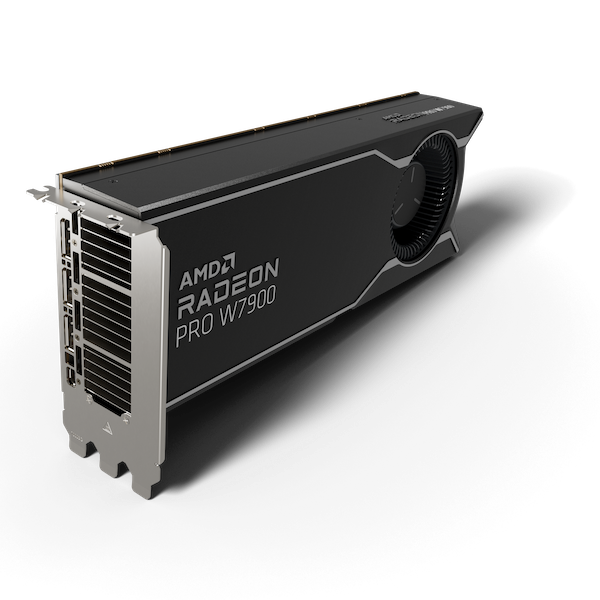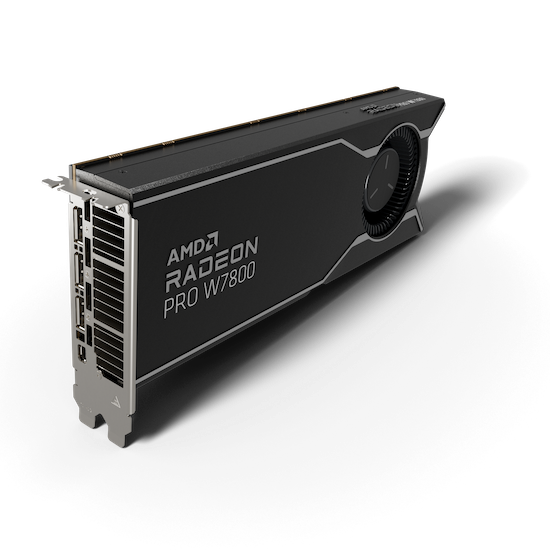AMD Releases More Powerful Radeon PRO GPUs
New Radeon PRO W7000 graphics cards offer 1.5-times the performance of the W5000 cards, at a low price point.

The AMD Radeon PRO W7900 offers 61 TFLOPS (FP32) peak single precision performance. Image courtesy of AMD.
Latest News
April 13, 2023
AMD has announced its new Radeon PRO W7000 Series graphics, which the comapny describes as its most-powerful workstation graphics cards to date. The AMD Radeon PRO W7900 and AMD Radeon PRO W7800 graphics cards are built on the AMD RDNA 3 architecture, and provide improved image fidelity and color accuracy, and run graphics and compute-based applications concurrently without disruption to workflows, the company says.
AMD Radeon PRO W7000 Series graphics cards feature the first workstation GPU architecture based on AMD’s advanced chiplet design, providing multi-tasking performance and power efficiency. The new graphics cards are also the first professional workstation GPUs to offer the new AMD Radiance Display Engine featuring DisplayPort 2.1 that delivers a a better visual experience, higher resolutions and more available colors than before, according to AMD.
The AMD Radeon PRO W7900 graphics card offers 61 TFLOPS (FP32) peak single precision performance, and 1.5X higher geomean performance on the SPECviewperf 2020 benchmark. It also includes 48GB of GDDR6 memory, which is 1.5X larger memory capacity than the 32GB available on the previous-generation graphics card. The AMD Radeon PRO W7800 graphics card features 45 TFLOPS (FP32) peak single precision performance and 32GB of GDDR6 memory.
“The new AMD Radeon PRO W7000 Series are the most powerful graphics cards AMD has built to date, providing professionals, creators and artists with exceptional performance and value to drive the most demanding professional design and creative applications,” said Scott Herkelman, senior vice president and general manager, Graphics Business Unit at AMD. “The AMD Radeon PRO W7900 and W7800 Series graphics cards are built to deliver incredible performance and reliability in professional applications, while providing color-critical accuracy and an incredible visual experience. The AMD Radeon PRO W7000 Series graphics cards give professionals the ability to tackle larger projects, render faster and create more complex models loaded with more pixels, more polygons, and more textures.”
The new W7000 series is particularly good at handling multitasking in compute-intensive environments. “These GPUs are for heavy to extreme workloads in design, manufacturing, architecutre and media,” said Jimmy Holbert, director of Radeon Creator & Workstation Strategy at AMD. “We think multitasking is one thing that impacts every modern professional across these verticals.”
In a briefing, AMD provided a comparative overview of the new Radeon PRO GPUs compared to their previous generation cards, as well as with NVIDIA RTX 6000 Ada GPUs. While the NVIDIA cards do provide slightly better performance according to some of those AMD metrics, the AMD Radeon PRO products are available at a lower price.
“We want to reiterate that that the AMD Radeon PRO W7900 is within 7 percent of the performance of the RTX 6000 Ada, but at half the price,” Holbert said. (AMD based that comparison on publicly available prices as of March 27, 2023.)

According to the company, key features include:
AMD RDNA 3 Architecture – New compute units share resources between rendering, AI, and raytracing to make the most effective use of each transistor, offering approximately 50% more raytracing performance per compute unit than the previous generation. AMD RDNA 3 architecture also features optimizations for AEC, D&M, and M&E workflows for rendering, video editing, and multitasking.
Advanced Chiplet Design – The world’s first workstation GPUs with a chiplet design provide higher performance and greater efficiency than the previous generation. It includes the new 5nm Graphics Compute Die (GCD) that provides the core GPU functionality. It also includes six new 6nm Memory Cache Die (MCD), each with second-generation AMD Infinity Cache technology.
Dedicated AI Acceleration and Second-Generation Raytracing – New AI instructions and increased AI throughput deliver over 2X more performance than the previous AMD RDNA 2 architecture4, while second-generation raytracing technology delivers significantly higher performance than the previous generation.
Up To 48 GDDR6 Memory – Allows professionals and creators to work with the largest 3D models and environments, edit and layer complex timelines using the latest digital cinema cameras formats and render photorealistic, raytraced images with unparalleled quality. Professional applications that can take advantage of the larger framebuffer include Adobe Premiere Pro & After Effects, Autodesk 3ds Max & Maya, Blender, Boris FX Sapphire, Dassault Systèmes SOLIDWORKS Visualize, DaVinci Resolve, Lumion, Maxon Redshift, and more.
AMD Radiance Display Engine with DisplayPort 2.1 – Supports the highest resolutions and over 68 billion colors and offers support for higher refresh rate displays compared to AMD RDNA 2 architecture and current competitive offerings. Display outputs support next-generation displays and multi-monitor configuration options, creating an ultra-immersive visual environment.
AV1 Encode/Decode – Dual encode/decode media engines unlock new multi-media experiences with full AV1 encode/decode support designed for high resolutions, wide color gamut, and high-dynamic range enhancements.
Improved Workstation Performance – The AMD Radeon PRO W7000 Series graphics cards compliment the AMD Ryzen Threadripper PRO processors by providing the horsepower necessary to handle demanding creative, production and visualization workloads quickly and efficiently, the company says.
Optimized Driver Performance – All AMD Radeon PRO workstation graphics are supported by AMD Software: PRO Edition, which provides a modern and intuitive user interface. Radeon PRO Image Boost renders visuals higher than a display’s native resolution to optimize image quality and resolution, while Radeon PRO Viewport Boost dynamically adjusts viewport resolution, boosting framerates and navigation performance in select applications.
The AMD Radeon PRO W7900 features an SEP of $3,999 USD. The AMD Radeon PRO W7800 features an SEP of $2,499 USD. The AMD Radeon PRO W7000 Series workstation graphics cards are expected to be available from etailers/retailers starting in Q2, 2023. Product availability in OEM and SI systems is expected in the second half of 2023.
Sources: Press materials received from the company and additional information gleaned from the company’s website.
More AMD Coverage

Subscribe to our FREE magazine, FREE email newsletters or both!
Latest News
Related Topics






